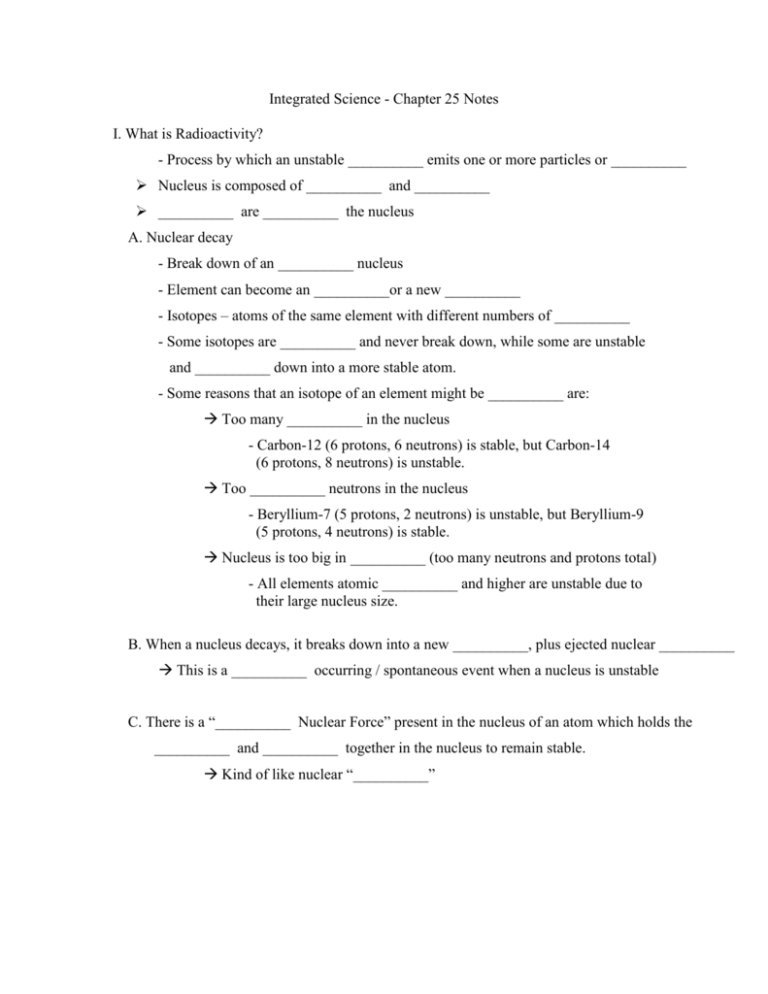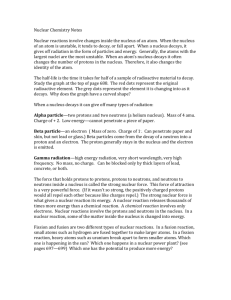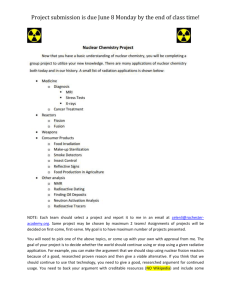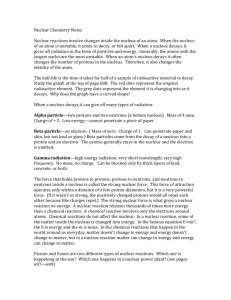Integrated Science
advertisement

Integrated Science - Chapter 25 Notes I. What is Radioactivity? - Process by which an unstable __________ emits one or more particles or __________ Nucleus is composed of __________ and __________ __________ are __________ the nucleus A. Nuclear decay - Break down of an __________ nucleus - Element can become an __________or a new __________ - Isotopes – atoms of the same element with different numbers of __________ - Some isotopes are __________ and never break down, while some are unstable and __________ down into a more stable atom. - Some reasons that an isotope of an element might be __________ are: Too many __________ in the nucleus - Carbon-12 (6 protons, 6 neutrons) is stable, but Carbon-14 (6 protons, 8 neutrons) is unstable. Too __________ neutrons in the nucleus - Beryllium-7 (5 protons, 2 neutrons) is unstable, but Beryllium-9 (5 protons, 4 neutrons) is stable. Nucleus is too big in __________ (too many neutrons and protons total) - All elements atomic __________ and higher are unstable due to their large nucleus size. B. When a nucleus decays, it breaks down into a new __________, plus ejected nuclear __________ This is a __________ occurring / spontaneous event when a nucleus is unstable C. There is a “__________ Nuclear Force” present in the nucleus of an atom which holds the __________ and __________ together in the nucleus to remain stable. Kind of like nuclear “__________” D. Types of Nuclear Radiation - Nuclear radiation – __________ or uncharged particles or energy emitted by unstable nuclei - All radiation can __________ with and affect surrounding __________ - _______________ – change from one element into a new element plus nuclear radiation - 4 Types of nuclear radiation 1. __________ particles (α) – positively charged, made of ___ protons and ___ neutrons - Most __________ nuclear radiation particle - __________ moving, and quickly loses __________ 2. __________ particles (β) – __________ charged, made of fast moving __________ - __________ mass - Penetrate matter, but not __________ 3. __________ rays (γ) – high __________, high penetrating power - __________ made of matter, no charge - Electromagnetic energy like light or x-rays, but with more energy - Stopped by 7 cm of lead - __________ hazard due to energy and penetrating ability 4. __________ emission – a single __________ with no charge - Can penetrate up to ______ cm of lead II. Nuclear Reactions A. Much __________ released into the surroundings during a nuclear reaction B. In a nuclear reaction, the nucleus __________ There are __________ types of nuclear reactions: 1. Nuclear ________ – process where a nucleus __________ (or is split) into two or more smaller nuclei and __________ energy Particles can cause __________ reactions of nuclear fission in surrounding atoms - This is an example of a nuclear __________ - Some practical uses of fission reactions are: Nuclear reactors for a __________ source __________ __________ 2. Nuclear Fusion – process where two nuclei __________ at very high temperatures to form a larger nucleus and releases energy This occurs continuously in __________ as hydrogen atoms (1 proton, 1 neutron) are joined together to form __________ atoms (2 protons, 2 neutrons). During the process, a __________ amount of __________ is also __________. - Some practical uses of fusion reactions are: We use this energy (__________ energy) to warm the __________, and __________ Plants use it to make food (_______________). We can __________ and convert solar energy into __________. C. Nuclear reactions, mass, and energy In both fission and fusion reactions, a small amount of __________ is converted into a large amount of __________ during the reaction. The Law of Conservation of __________ still applies, as matter (which has mass) is not created or __________, but the form is __________. During the change in form, energy is __________ as the matter becomes more stable, with __________ energy. III. Dangers and Benefits of Nuclear Radiation - There are both __________ and negatives to __________ radiation and nuclear __________ A. Dangers can __________ skin, can ionize living __________, can destroy cells, can cause __________, can cause genetic __________ in DNA, radiation __________ B. Benefits can be used to __________ diseases, used in __________ detectors, tracers used in __________, __________, research, __________ source C. There are __________sources of radiation all around you. __________ gas in the atmosphere and soil Carbon-14 inside your __________ and every living thing __________ (medical, from the sun, from elements in the earth) Cosmic __________ from space Rocks and __________ with radioactive materials IV. Half-life - Some radioisotopes decay to stable atoms in less than a ____________. - However, the nuclei of certain radioactive isotopes require millions of ____________ to decay. - A measure of the ____________ required by the nuclei of an isotope to decay is called the ______-life. - The half-life of a radioactive isotope is the amount of time it takes for half the nuclei in a sample of the isotope to decay. - The nucleus left after the isotope decays is called the ____________ nucleus. - Half-lives ____________ widely among the radioactive isotopes. - The number of half-lives is the amount of ________ that has passed since the isotope began to decay. - For example: If you have 100 atoms of a sample of Carbon-14, and the half-life of that isotope is 5730 years, how many atoms are left after 2 half-lives? 100 atoms 50 atoms 25 atoms 1st half-life 2nd half-life 2nd Example : If you started with 1000 atoms of a sample of Iodine-131, and you have 8 atoms left, how much time has passed? Half-life of Iodine-131 = 8.04 days Step 1: Determine number of half-lives 1000 500 250 125 63 32 16 8 1 2 3 4 5 6 7 **7 half-lives** Step 2: What is the half-life of the isotope? Half-life of Iodine-131 = ____________days Step 3: Multiply # of half-lives and half-life time ______ half-lives x 8.04 days = ___________ days half-life








